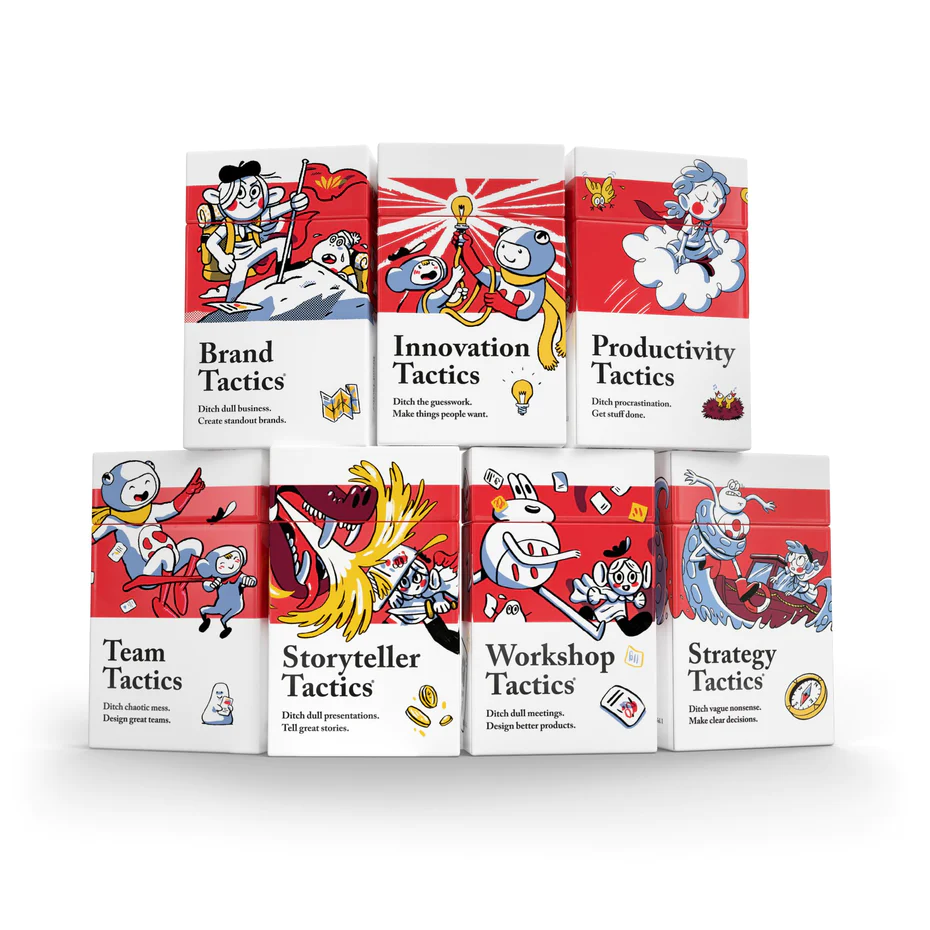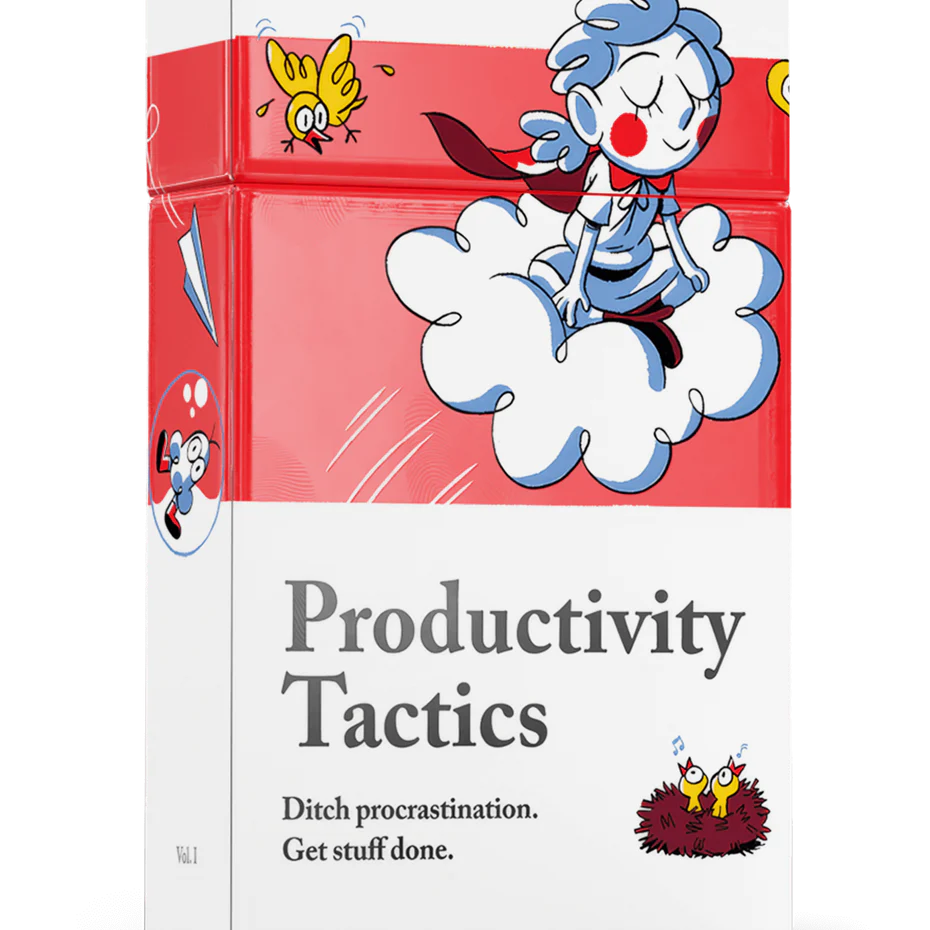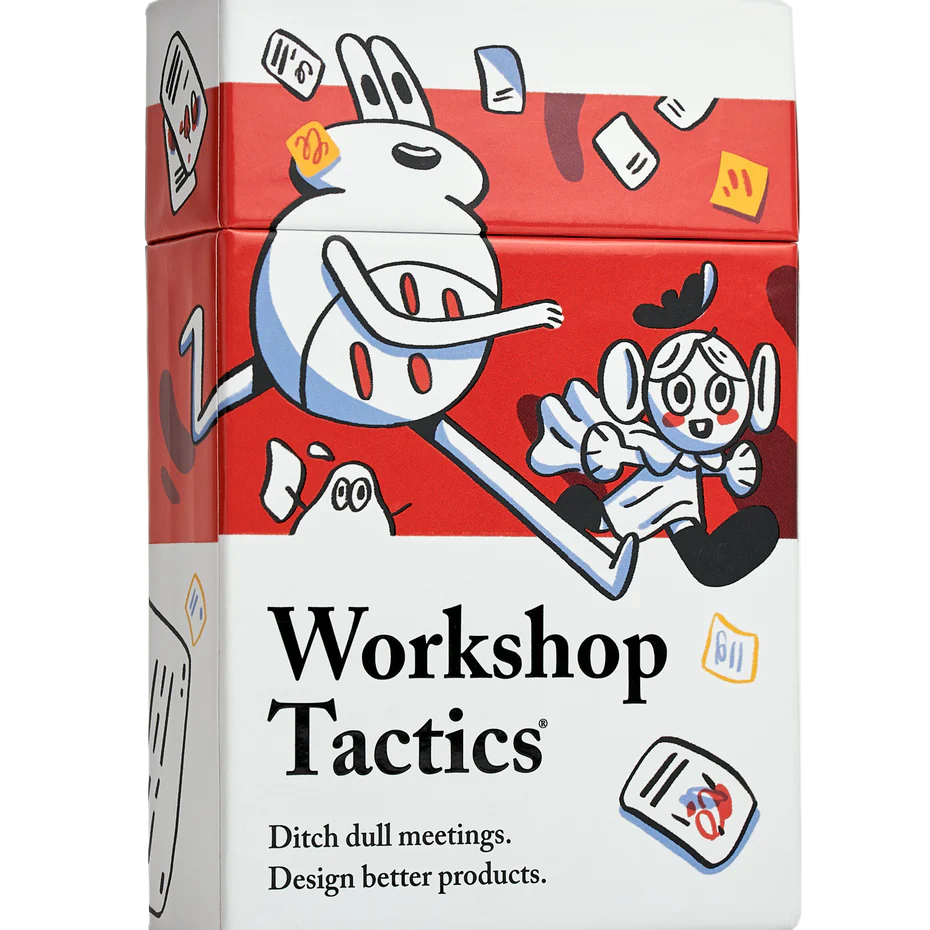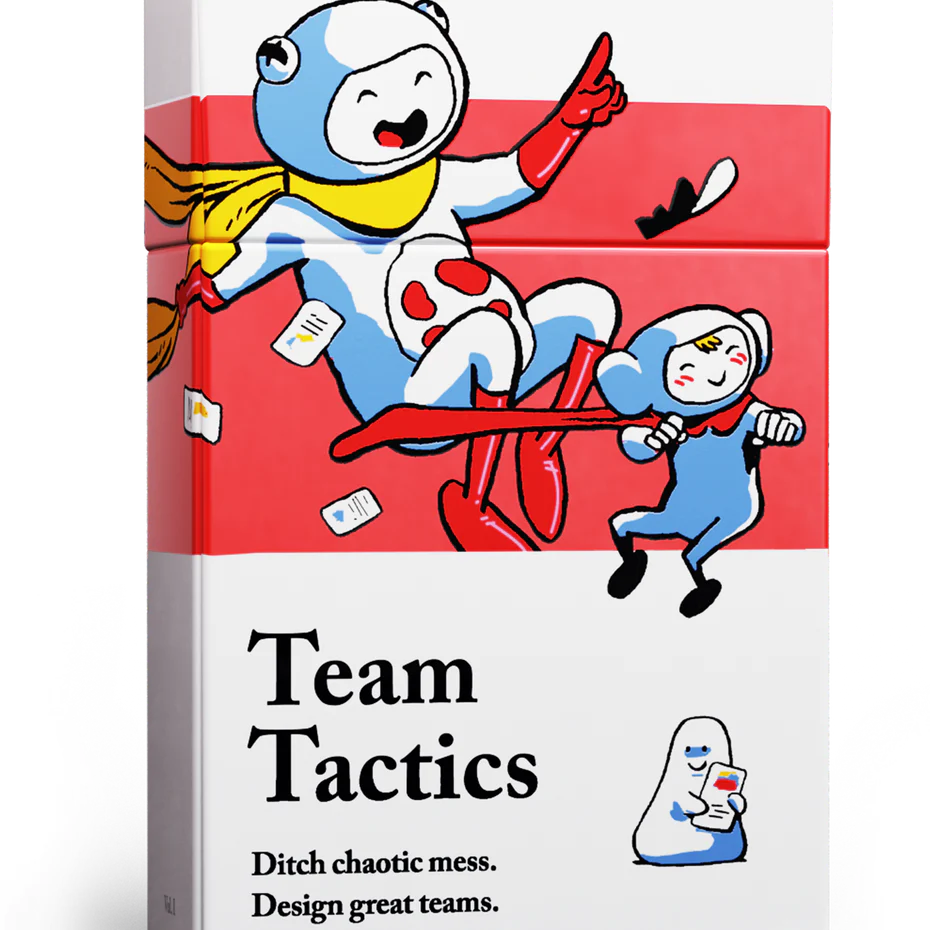Productivity Tactics Review
Is the Productivity Tactics deck by Pip Decks capable of improving your capacity to meaningfully get work done? Let’s take a look at the deck and its underlying foundation in productivity research to get a sense about how it works. Let’s find out with this Productivity Tactics review.
You have probably seen the Productivity Tactics deck promoted along with the other tools produced by Pip Decks on Instagram, Facebook, TikTok and Linked in and and wondered if they actually increase productivity at work… Well, I’ve been using Pip Decks for a two years, starting with Storyteller Tactics and working my way through the whole set. In this Productivity Tactics Review we will dig into the productivity system promoted in the deck to see how we can apply it to our work and our everyday lives.
But why listen to me? As part of my background, I hold an MBA in business with an emphasis on Management and Strategy, and I spent 20 years working with and managing teams in a design college. To help you get a sense of whether the Productivity Tactics deck can help you, I’ll share some of my experience and talk about where this deck fits in with the work of creativity and innovation.
I’ve also got an affiliate link, so that if this information is helpful, you can get your deck, contribute something back here (I receive a small commission on each sale), AND get a 15% discount on Productivity Tactics and anything else you add to your purchase. Just make sure you see MURDOCKMEDIAPRODUCTIONLLC in the discount code/gift card field.
So, here it is – the good the bad and the ugly… Productivity Tactics Review
What are Pip Decks?
Pip Decks are a card-based system that helps you identify work that needs to be done and to organize it into bite-sized pieces. Each area that you want or need to work on is structured into processes to help you tackle that phase of work.
These processes aren’t all task based, but they are all actionable. In one stage you might be prompted to reflect. In another, to organize. In yet another, to plan. By breaking the challenges addressed by each deck, from storytelling to branding and on to productivity into manageable pieces, the Pip Decks provide a roadmap that can help anyone, from novice to expert to approach their work in new ways.
As your scenario changes, so can your use of the decks. Topics addressed by the various decks include productivity tactics (reviewed here), storyteller tactics, brand tactics, innovation tactics, strategy tactics, workshop tactics, and team tactics.
This article will review the Productivity Tactics deck, but to explore the full set of decks, click the image of the full set near the top of the page (yes, it is an affiliate link).
The Productivity Tactics deck includes 54 productivity cards that are broken down into manageable journey.
The deck is built to help individuals and teams to get organized – to plan, organize and move projects from concept to completion while maintaining mental space and managing or avoiding burnout.
Productivity Tactics review what’s included:
- a “productivity strategy system” to help identify where to focus based on where you are in your project or work journey
- “recipes,” that help you through common challenges (burnout, deep work, project planning, making choices about what you want to do with your time and life, teamwork and refreshing your mind);
- framing questions – are you ready to work, do you know what you are working on, do you have a plan?
- preparation – a set of cards that help you ready the journey
- plan – tools to set goals and milestones along the way
- prioritize – evaluative methods to identify what to tackle first
- do – actionable steps that can create a system to make work repeatable and efficient
- reflect – cards that help you evaluate and improve processes
- manage time – cards that help you reduce the number of projects to those you really want to work on
- and “reset” cards that help you when nothing is working, or it’s time to prepare for a new round of productivity development.
Productivity Tactics Review
Let’s kick off this productivity tactics review with the big picture. Productivity is a field that started in operations and management – how do we get the most out of a manufacturing, assembly, or other production floor? If you study management, you’ll likely take a course in operations, and you’ll learn formulas for evaluating how many staff on hand you need in order to effectively manage queuing in a checkout line, how many of these machines, and how many of that to prevent bottlenecks.
Productivity has evolved from this kind of assessment based on shifting work requirements. Today, individuals need to remain productive, even under a variety of task, analytical, and decision pressures. while A myriad of distractions impede – friends, family, social media, peer conversations, even your browser’s prompts to read the latest articles can get in the way. What is an innovation leader to focus on when their responsibilities span environmental scanning, product and service development, coaching, and leadership?
This is the type of productivity challenge that Productivity Tactics was developed to address. Reading through the deck, I see processes in place to address the following challenges questions:
Identifying your motivators – we each have things we prefer to focus on. Are we really putting our energy and focus in the right place?
Ideation – the foundation for most types of creative work start with ideation. Where do our ideas naturally want to take us, and can our idea processes effectively support our work?
Planning – when we have a useful idea or set of ideas, what do we need to create and what processes do we need to put in motion to move from idea to fruition?
Creating and taking steps – Within a larger plan, identifying, organizing, and then actually taking steps to make work manageable and actionable. How can we most effectively get the ball rolling without creating too much rework?
Creating healthy routines – once we have a plan, how can we create our day around moving each element of the plan forward?
Clearing cluttered tasks – as we move ahead, naturally we create a list of minor tasks that really need to be completed but seem never to make it up to top priority. How can we address these tasks so they are resolved and don’t distract us from moving the ball on our major work?
Structuring time – should we build timelines around tasks, our energy levels throughout the day, our ability to focus, short bursts, or some combination of all of these?
Documenting and tracking work progress – when we create a plan, if we use the planning document for tracking, it can seem impossible to progress. How should we organize plans, and how should we track progress as we work?
Identifying causes of negative stress – some stress can cause excitement and engagement, while other stress wears us down, reduces motivation, and results in delays and dissatisfaction. How can we identify negative stress early and put it on the ‘manageable’ list?
Retro evaluations and feedback – When projects wrap up, what can we do to assess the process, learn lessons, and apply them to future work?
Recognizing successes – how can we provide rewards and recognition to ourselves and others to recognize when we’ve had a win?
Stay present – mindfulness has become more and more important for individuals as work has become more complex and the variety of inputs greater. How can we do our work with care and avoid the challenges that come with carelessly checking off a task list?
mix things up – variety is the spice of life. How can we mix up our daily routine to stimulate our minds and find something new?
recover and recoup – people need downtime. what are some ways we can take a break so we can come back to work refreshed?
and the 11 key principles of productivity – how has productivity changed to meet today’s creative work?
How do you use the Productivity Tactics cards?
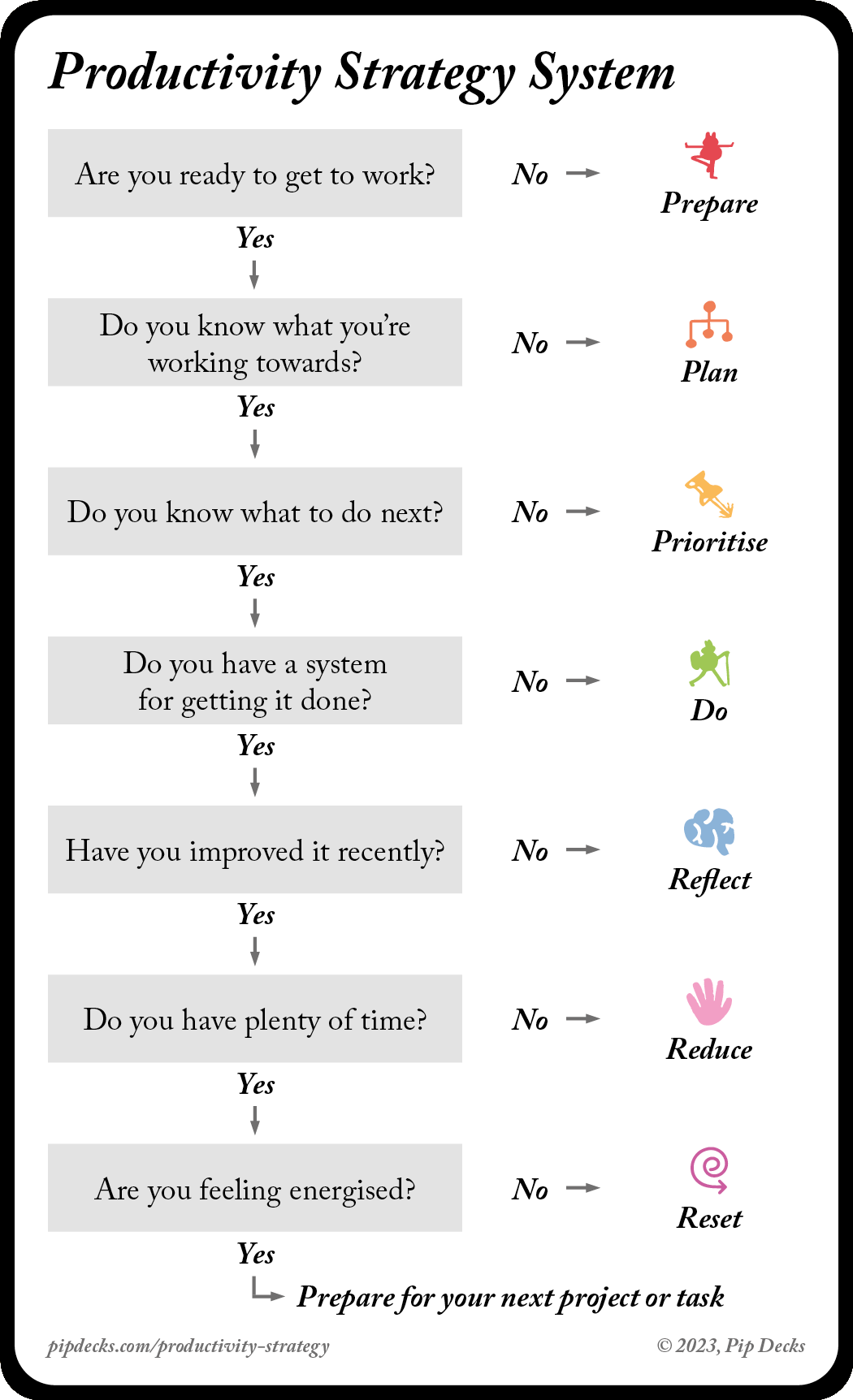
The best tactical place to start is with the Productivity System card. The author has broken down productivity into a series of questions and then has developed processes we can use to resolve the question. The cards are color coded: red to prepare for work, orange to plan, yellow for prioritization, green for doing the work, blue for reflecting on the work, pink for reducing work, and violet for taking time to reset and get ready for a new round of work.
Not every challenge calls for every stage in the productivity strategy system, and not every card is necessary to move ahead. The system is a map, but each of us need to choose our own path through the landscape of work. progresses through a series of questions to help you identify which group of cards to start with.
To be totally honest, I work with productivity in fits and starts. Most of the content in “prepare” is work I’ve done or that I regularly engage in – mindfulness, sunrise scribblings – for me, these are at the heart of creativity, and they come very naturally to me. That’s not to say they aren’t a good reminder.
I also plan really well. I just don’t plan and implement at the same time really well. For me, it’s one or the other… until now.
Because of that little factoid, “Prioritize,” “Do,” and “Reduce” are where the rubber meets the road.
If you’re at all like me, you might take on too many projects. You might see how they can all get done, but not realize you’re imagining the same blocks of time for multiple projects. You might get muddled on where to start, which tasks or projects to prioritize, and how to get yourself unstuck once you are knee deep in four projects and saying “yes” to a fifth. A productivity tactics review helps me. I follow the productivity strategy system looking for opportunities for refinement, then I choose the cards and processes that help me adjust.
A second great place to start is with the recipe cards – a set of tan color coded cards that follow a particular challenge from start to finish. There’s a recipe for burnout management, planning days around deep work, choosing work that is truly meaningful to you, project planning, giving teamwork a jump start, and clearing the decks for new projects. Each recipe, except for the project planning recipe, pulls five card from the deck, starting with a preparation card and working through various stages of solving the challenge. The project planning recipe is unique in that all of the cards come from the orange “planning” cards in the deck.
When is it necessary to use productivity tactics?
Productivity tactics address a number of common personal and interpersonal challenges to moving projects ahead and getting work done. Overwhelm, distraction, prioritization, ownership, collaboration, teamwork – these are the common areas where bottlenecks occur. Anyone who has run into these challenges in life or work can benefit from the Productivity Tactics deck.
And the deck isn’t just useful one time. As you work, it’s helpful to come back to the deck, sort through it, identify your current and next steps so you can mentally frame the scenario in a way that will allow you to continue progress. And like one of the cards says, one step is enough to keep a project moving. One step today, one step tomorrow – rinse and repeat.
Even with something as simple as reviewing this deck, I use the “one step” process. Build the page, select, name and add images, outline the questions, write the content, publish, distribute. Years ago, when I started reviewing books, I’d read the book and try to write and publish as one complete task. Doing that made an enjoyable project eventually become a chore. It was hard to maintain consistency. By breaking the assessment, review, writing, and publishing elements down into bite sized pieces, I’m able to fit the steps in between other work, so the project keeps moving forward. My job becomes to keep coming back to take the next step. This is one way the deck can reduce stress and anxiety around “completing” a task. It shifts the “task” of publishing a review into a “process” with many micro steps along the way.
Why now? What’s with this approach to productivity?
The reason that individual productivity has taken off in businesses around the globe is that work has changed. People have more responsibility and it takes more knowledge to conduct work, even in jobs that historically were considered wrote tasks.
In manufacturing, workers need to be able to read data from machines and adapt accordingly. In offices, there’s no “front desk” job that simply waits for people to walk in or for the phone to ring. Competing demands are everywhere. There’s very little work that is mandated from on high, and in many workplaces, employees have the responsibility of identifying and bringing innovative opportunities to the organization.
Reviewing productivity tactics can be a part of creating a culture of ongoing improvement. By drawing on the processes in the deck based on each business scenario you and your team find yourselves in, you can help resolve the situation so you can move forward. Suppose everyone is burned out because of a set of projections that aren’t being met because a change in customer sentiment due to economic markers – draw from cards that help your team think creatively. There’s nothing better for to removing this kind of stress than finding a way to adapt to get back on plan. At the same time, look for ways to allow the team to reset and re-calibrate so work doesn’t feel like it’s just about rushing from one emergency to the next.
Because of the deck’s focus on creating plans and strategies to adapt to various personal and business scenarios, it’s a tool for empowering yourself and your team to be creative, sometimes in the smallest of ways. Does the team have a communication problem? Use the Communication Canvas card to map out the ways communication flows and how it can change. What communications should be in person with a group. Where do one-on-ones make sense, and when should communication be asynchronous through an online board or project management tool? The card helps you sort through and make a plan that can be tested and refined over time.
So, are the Productivity Tactics good at what they do?
On the whole, yes! I’ve used the cards to plan and activate personal projects as well as to motivate and coordinate with others in a work team. For today’s project work, which often includes a combination of knowledge, skill, timing, coordination, and collaboration, the processes included in the Strategy Tactics deck are a solid review of leading thought in the field of productivity. In fact, there’s a “Productivity Principles” card which references each of the key cards addressing a leading topic in the field. You would need to read 11 or more books to get the gist expressed in this card and the 18 cards referenced in this one recipe for success.
But, of course, there is opportunity to grow. In my experience, if you wanted to really dive into project management, which includes the Kanban method described in this deck, you’d also need to look at topics like critical path, creating work dependencies (where one part of the project relies on another part being finalized and approved before proceeding), collecting time and cost estimates (including expendables and outside services needed for project support) from teams and team leads, budgeting, estimating slack time, and so forth. A book like Fundamentals of Project Management (affiliate link) byJoseph Heagney could be an excellent adjunct to the Productivity Tactics deck.
Where does the Productivity Tactics deck perform the strongest? Let’s review.
The Productivity Tactics deck is excellent when you need to address personal and interpersonal challenges like overwhelm, burnout, focus, planning, collaboration, project coordination and planning with a team. The deck works exceptionally well in concert with decks like Team Tactics and Workshop Tactics, both produced by Pip Decks. (Read a review of each at the link from each deck title).
How can I get the most out of my Productivity Tactics Pip Deck cards?
Pip Decks are part of a larger trend in design thinking, teamwork, brand, and sales development that has developed since the 1990’s, so using them in relation to today’s personal, business, or nonprofit projects is a great place to start.
The best way to use this deck, or any of the Pip Decks, is to purchase the cards and to commit to a regular review – what is my productivity scenario this week? Go thorough the productivity system at regularly scheduled intervals. Ask yourself the questions, or ask the questions with your team. Where to people feel stuck? Where do they have confusion? What processes will help break through barriers in order to get to efficient outcomes?
Keep a journal (that’s part of one of the cards) to help you see trends over time. Review it monthly or quarterly to identify things that repeat and those that are resolved through your work on productivity.
Ready to give it a go? Follow the links below to purchase one or more of the decks. Make sure you see MURDOCKMEDIAPRODUCTIONLLC in the discount code/gift card field to get your 15% discount off your entire order.

